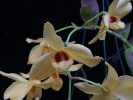|
|
|
|
|
| |
Flasks of
Dendrobium moschatum var. cupreum '#1' × self |
|
| |
|
|
| |
| Number: |
TN5688 |
| Name: |
Dendrobium moschatum var. cupreum '#1' × self
|
| |
Low yield; be sure to select the Notify Flask Recipients option if you want to get individual seedlings.
|
| Type: |
self (What's that?) |
|
Seed Donor: |
(Email: drmorris@bendbroadband.com)
|
|
Click to Enlarge

Pod Parent Flower |
Click to Enlarge

Offspring 'MC7337' Flower |
| Offspring photos are siblings of the plants you would receive. |
|
|
|
| |
Culture Notes from Donor: Parent plant: Temperature range CI (58-75°F)
Comments: Parent plant: Very large plant.
For additional origin/habitat information supplied courtesy of
Charles and Margaret Baker, see further below, near the bottom of this page.
|
Temperatures we attempt to use in the lab & greenhouse:
| For Infraspecies: |
|
Spring, Summer, Autumn: days average 84°F, nights 71°F; best fit is Warm 90-70°F
(Source:
Baker's Web OSC) |
| For Infraspecies: |
|
Winter: days average 65°F, nights 50°F; best fit is Cool-Cold 64-44°F
(Source:
Baker's Web OSC) |
| For Species: |
|
Spring, Summer, Autumn: days average 84°F, nights 71°F; best fit is Warm 90-70°F
(Source:
Baker's Web OSC) |
| For Species: |
|
Winter: days average 65°F, nights 50°F; best fit is Cool-Cold 64-44°F
(Source:
Baker's Web OSC) |
|
About the name...
| Etymology of |
cupreum |
|
From Latin "cupreus" copper-colored.
(Source:
Mayr & Schmucker 1998) |
| Etymology of |
Dendrobium |
|
From Greek "dendron" tree and "bios" life.
(Source:
Pridgeon 1992) |
| Etymology of |
moschatum |
|
From Latin, "moschatus" perfumed with musk.
(Source:
Brown 1956) |
| Pronunciation of |
cupreum |
|
KOO-pree-um
(Source:
Hawkes 1978) |
| Pronunciation of |
Dendrobium |
|
den-DRO-bee-um
(Source:
Pridgeon 1992) |
| Pronunciation of |
moschatum |
|
mos-KAH-tum
(Source:
Hawkes 1978) |
|
If you would like to direct someone to this web page, please copy and paste this URL into your email:
http://troymeyers.com/d?015688
| Flask Information |
| Availability: |
We have sold all of the flasks for this item. |
| You should: |
Consider getting individual plants or compots instead of a flask.
You can place a "Notify Flask Recipients" Request, and either we or a flask recipient may contact you when plants are available.
You may also place a "Notify Retries" Request, and if an identical pollination (the same parents) is done again, we'll let you know.
You may reserve a flask, but it's very unlikely you'll get one ...this could only happen if we found a flask that we didn't know we had. |
| Yield Estimate: |
75 plants (based on flask surveys done 03/29/2007 through 08/16/2007)
|
| Plantlet Sizes: |
From many flasks 30 - 75 mm plants (based on flask surveys done 07/06/2007 through 11/14/2007)
From one most recently surveyed flask 35 - 75 mm (11/14/2007)
|
|
You might also want to:
|
View the seed assay for this item.
View items of the same species.
View items of the same genus.
|
| Ordering Information |
| You are not currently logged in. |
|
You must be a registered user and be logged in to reserve a flask or place a notification request. Please log in:
|
|
|
|
|
|
| |
The origin/habitat information below is supplied courtesy of Charles and Margaret Baker
The following information is based on the name of the plant provided by the donor, and assumes that the name is correct. If the plant has been misidentified, then the following information may not be correct.
This text is copyrighted by the Bakers and may not be reproduced without permission.
ORIGIN/HABITAT: Northwestern Himalayas including the Dehra Dun region in
northern India, Nepal, Sikkim, Bhutan, and the Assam region in the
northeast India. Plants grow at 1000-6550 ft. (300-2000 m). They are also
found at moderate to high elevations in lower Burma, Thailand, and Laos;
and plants have been reported in Yunnan Province of southwest China.
Plants usually grow at the tops of tall deciduous trees with high light
and brisk air movement.
More about this information and the Bakers...
|
|
|
| |
|
|
|